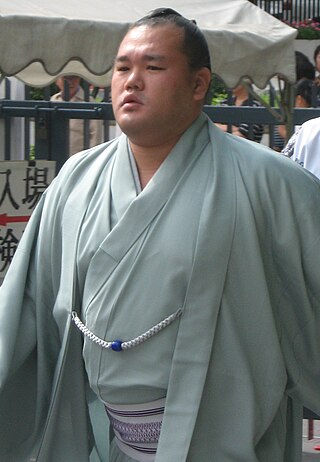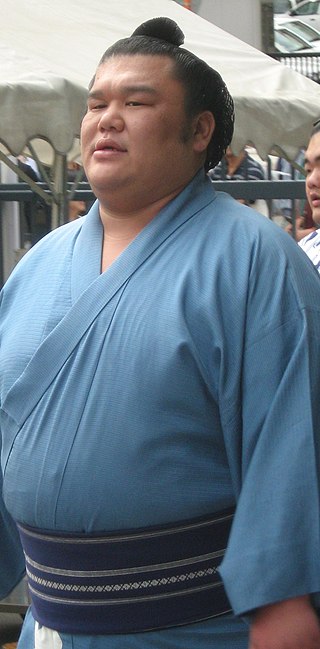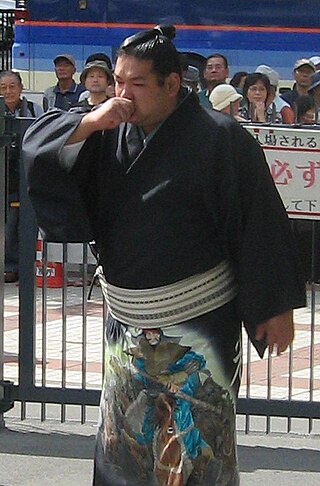
Tochinoumi Teruyoshi was a Japanese professional sumo wrestler from Aomori. He was the sport's 49th yokozuna, earning promotion in 1964. He was somewhat overshadowed by his yokozuna contemporaries Taihō and Kashiwado, but he was a noted technician and earlier in his career won six special prizes for Technique. He was one of the lightest yokozuna ever at just 110 kg. After his retirement from active competition in 1966 he was a coach at Kasugano stable, and was head coach from 1990 until his retirement in 2003.

Kasugaō Katsumasa is a former sumo wrestler from Incheon, South Korea. He was the first sumo wrestler to reach the top makuuchi division officially representing South Korea.. He joined sumo in 1998, making the top division for the first time in 2003. His highest rank was maegashira 3. In September 2009, he acquired Japanese citizenship. In April 2011 he was ordered to retire by the Japan Sumo Association after an investigation found him guilty of match-fixing.
Hitoshi Tochihana is a former Japanese sumo wrestler from Yamagata, Iwate. A former amateur champion, he turned professional in 1995, reaching the top makuuchi division in 2000. His highest rank was komusubi. He retired in 2008 and is now a sumo coach.

Jūmonji Tomokazu is a former sumo wrestler from Aomori, Japan. Joining the professional ranks in 1992, he reached the top division in 2000 and was ranked there for 34 tournaments until 2007. His highest rank was maegashira 6. He was forced to retire in April 2011 after an investigation by the Japan Sumo Association found him guilty of match-fixing.

Toyozakura Toshiaki is a former sumo wrestler from Hiroshima, Japan. He made his debut in 1989, and after many years in the lower ranks he reached the top division for the first time in 2003. His highest rank was maegashira 5. He was a runner-up in one tournament and earned one special prize for Fighting Spirit. He is the younger brother of Kitazakura. He was forced to retire in April 2011 after an investigation by the Japan Sumo Association found him guilty of match-fixing.

Tochisakae Atsushi is a former sumo wrestler from Saga Prefecture, Japan. He made his professional debut in 1993, reaching the top division for the first time in 2000. His highest rank was maegashira 1. He suffered many illness and injury problems throughout his career. He retired in 2008 and is now an elder of the Japan Sumo Association under the name of Mihogaseki, working as a coach at Kasugano stable.

Tamaasuka Daisuke is a former sumo wrestler from Atsuta-ku, Nagoya, Aichi Prefecture, Japan. He made his professional debut in March 1998. His highest rank was maegashira 9. He was well known for moving between the top makuuchi division and the second jūryō division on several occasions. He won two makushita and two jūryō division championships. He retired in September 2016 and is now a sumo coach.

Tochinowaka Kiyotaka is a former sumo wrestler from Wakayama Prefecture, Japan. A former amateur champion, he turned professional in 1985, reaching the top makuuchi division in 1987. His highest rank was sekiwake. He was a runner-up in one tournament and earned six special prizes and four kinboshi. After 76 tournaments and 1114 bouts in the top division he retired in 1999. He is now an elder of the Japan Sumo Association and the head coach of Kasugano stable.

Kasugano stable is a stable of sumo wrestlers, part of the Dewanoumi ichimon or group of stables. As of January 2023 it had 17 wrestlers. It has been led by former sekiwake Tochinowaka Kiyotaka since 2003. It was one of the most successful stables in 2013, with six sekitori wrestlers, including now retired Georgian Tochinoshin and Japanese born Tochinowaka Michihiro, who used the current head coach's old ring name.

Kiyoseumi Takayuki is a former sumo wrestler from Nagoya, Japan. An extremely successful amateur, his highest rank in the professional sport was maegashira 13. He was forced to retire in April 2011 after an investigation by the Japan Sumo Association found him guilty of match-fixing.

Chiyohakuhō Daiki is a former sumo wrestler from Yamaga, Kumamoto, Japan. He made his professional debut in 1999 and broke into the top makuuchi division nine years later in 2008. His highest rank was maegashira 6. He wrestled for Kokonoe stable. After admitting his involvement in match-fixing, he retired from the sport in 2011 following an investigation by the Japan Sumo Association.

Masatsukasa Kōshin is a former sumo wrestler from Aomori Prefecture, Japan. His highest rank was maegashira 8. He was forced to retire in April 2011 after an investigation by the Japan Sumo Association found him guilty of match-fixing.

Shōtenrō Taishi is a former sumo wrestler from Khovd Province, Mongolia. He joined professional sumo in 2001 and was known as Musashiryū Taishi until 2007. He made the top makuuchi division for the first time in 2009 and his highest rank was maegashira 2. He wrestled for Fujishima stable. He acquired Japanese citizenship in 2017 and retired shortly before the January 2018 tournament to become an elder of the Japan Sumo Association. As of June 2022 he is known as Nishikijima Oyakata.

Kimurayama Mamoru was a Japanese professional sumo wrestler. His highest rank was maegashira 7. He was a coach at Kasugano stable. He was the only wrestler in the elite ranks in his time from Wakayama Prefecture.

Mōkonami Sakae is a former sumo wrestler from Mongolia. After making his professional sumo debut in March 2001, he had his top makuuchi division debut 8 years later in July 2009. His highest rank was maegashira 6. He has acquired Japanese citizenship. In April 2011 he was ordered to retire by the Japan Sumo Association after an investigation found him guilty of match-fixing.

Kōryū Tadaharu is a Mongolian former sumo wrestler from Ulan Bator. His highest rank was maegashira 11. He was forced to retire from sumo in 2011 after being found guilty of match-fixing.

Kotokasuga Keigo is a former sumo wrestler from Kasuga, Fukuoka Prefecture, Japan. He began his professional career in 1993, reaching the top makuuchi division some 15 years later in 2008. His highest rank was maegashira 7. He retired in April 2011 after the Japan Sumo Association found him guilty of involvement in match-fixing.
The following are the events in professional sumo during 2011.

Tochinowaka Michihiro is a former sumo wrestler from Hyogo, Japan. His father is a Zainichi Korean and his mother is a Korean immigrant. He made his professional debut in 2007 and steadily rose through the ranks. His highest rank was maegashira 1.

Kōtetsuyama Toyoya, born Kōnoshin Suga, was a sumo wrestler from Otaru, Hokkaidō, Japan. His highest rank was sekiwake. After his retirement he became an elder of the Japan Sumo Association and the head coach of Onaruto stable.


















